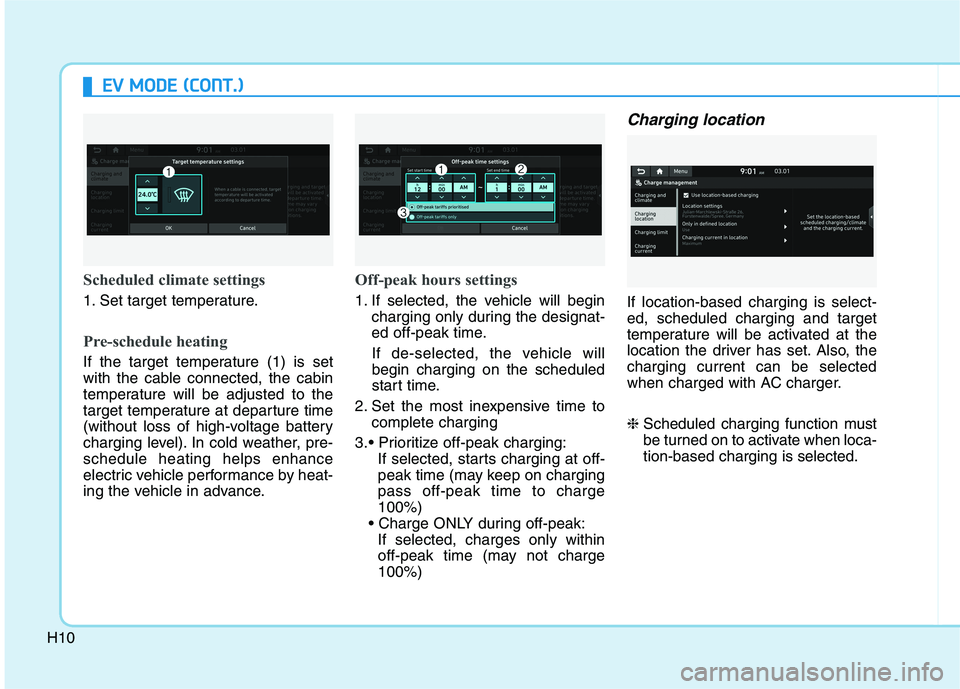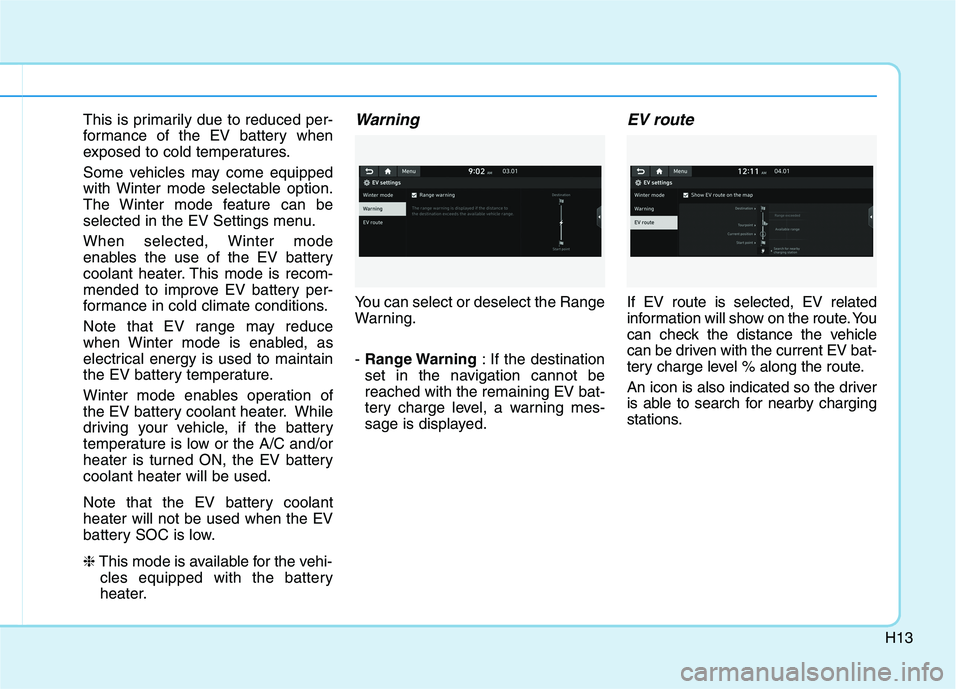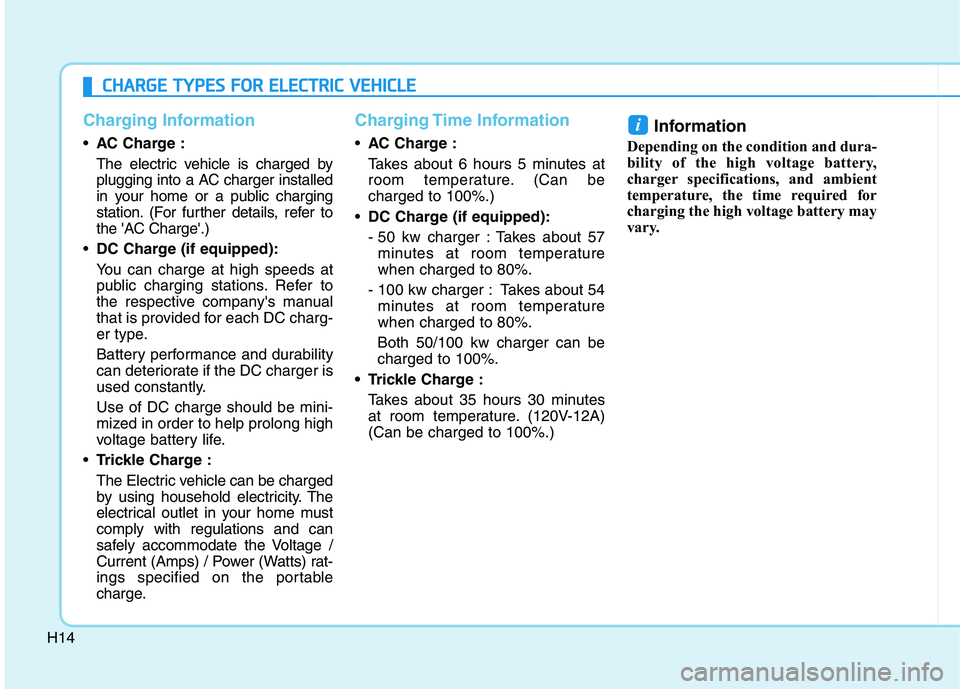Page 18 of 546
H9
➃‘Battery care’ shows the momen-
tary power and energy consump- tion which are used when:
increase the battery temperature
during winter to improve the driv-
ing performance.
ature during summer to prevent
over temperature of the battery.
Charge Management
Select ‘EV � Charge Management’
on the screen. You can set the date and time of when to charge the bat-
tery, climate control temperature,location-based charging options and
other various functions.
Charging and climate
You can set the date and time of
when to charge the battery and the
climate control temperature. Also,
you may select the time to startcharging using the off-peak hourssetting.
Departure time
1. Set the anticipated departure time for scheduled charging and target
temperature.
2. Select the day of the week to acti- vate scheduled charging and target
temperature for departure time.
Page 19 of 546

H10
EEVV MM OODDEE (( CC OO NNTT..))
Scheduled climate settings
1. Set target temperature.
Pre-schedule heating
If the target temperature (1) is set
with the cable connected, the cabin
temperature will be adjusted to the
target temperature at departure time
(without loss of high-voltage battery
charging level). In cold weather, pre-schedule heating helps enhance
electric vehicle performance by heat-
ing the vehicle in advance.
Off-peak hours settings
1. If selected, the vehicle will begin
charging only during the designat-
ed off-peak time.
If de-selected, the vehicle willbegin charging on the scheduled
start time.
2. Set the most inexpensive time to complete charging
If selected, starts charging at off-
peak time (may keep on chargingpass off-peak time to charge100%)
If selected, charges only within
off-peak time (may not charge100%)
Charging location
If location-based charging is select-ed, scheduled charging and target
temperature will be activated at the
location the driver has set. Also, thecharging current can be selected
when charged with AC charger. ❈ Scheduled charging function must
be turned on to activate when loca-tion-based charging is selected.
Page 20 of 546
H11
Charging limit
The maximum charging limit canbe selected for either DC fast
charging (DC charger) or Level 1 /
Level 2 charging (AC charger).
Charging will stop when the vehicle
reaches the designated battery
charge level.
The maximum charging limit can be adjusted in 10% increments. Note that if the battery charge level
(SOC%) is above the designated
maximum charging limit, the vehi-cle will not be charged.
Charging current
For Level 1 or Level 2 charging,you can also adjust the charging
current. Select the appropriatecharging current based on the type
of charger and current capacity.
If the charging process does not start or abruptly stops in the mid-
dle, re-select another proper cur-
rent and re-try charging the vehicle.
Charging time varies depending on which charging current is selected.
ECO Driving
Select ‘EV �ECO Driving’ on the
screen. You can check the CO2
reduction and ECO driving history.
Page 21 of 546
H12
CO2 reduction
The CO2 reduction display allows
you to monitor the benefits of
reduced greenhouse gas emissions
of your EV relative to a conventional
gasoline vehicle. While driving your
vehicle, the display estimates the
amount of reduced CO2 that would
have been emitted from tailpipe
emissions of a conventional vehicle.
Driving history
The driving history displays informa-
tion from the last several driving
cycles including date, distance trav-
eled and energy efficiency rate. A
star icon indicates the driving cyclewith the most efficient energy con-
sumption rate.
EV Settings
Select ‘EV �ECO Settings’ on the
screen. You can set the Winter mode,
Warning and EV route functions.
Winter mode for the EV Battery
In cold climates and during winter
months, electric vehicle range may
reduce and charging times may
increase.
Page 22 of 546

H13
This is primarily due to reduced per-
formance of the EV battery when
exposed to cold temperatures.
Some vehicles may come equipped
with Winter mode selectable option.
The Winter mode feature can be
selected in the EV Settings menu.
When selected, Winter mode
enables the use of the EV battery
coolant heater. This mode is recom-
mended to improve EV battery per-
formance in cold climate conditions.
Note that EV range may reduce
when Winter mode is enabled, as
electrical energy is used to maintain
the EV battery temperature.
Winter mode enables operation of
the EV battery coolant heater. While
driving your vehicle, if the battery
temperature is low or the A/C and/or
heater is turned ON, the EV batterycoolant heater will be used.
Note that the EV battery coolant heater will not be used when the EV
battery SOC is low. ❈This mode is available for the vehi-
cles equipped with the battery
heater.Warning
You can select or deselect the Range
Warning. - Range Warning : If the destination
set in the navigation cannot be reached with the remaining EV bat-
tery charge level, a warning mes-
sage is displayed.
EV route
If EV route is selected, EV related
information will show on the route. You
can check the distance the vehicle
can be driven with the current EV bat-
tery charge level % along the route.
An icon is also indicated so the driver
is able to search for nearby charging
stations.
Page 23 of 546

H14
Charging Information
AC Charge :
The electric vehicle is charged by
plugging into a AC charger installed
in your home or a public charging
station. (For further details, refer to
the 'AC Charge'.)
DC Charge (if equipped):
You can charge at high speeds at
public charging stations. Refer to
the respective company's manual
that is provided for each DC charg-
er type.
Battery performance and durability
can deteriorate if the DC charger is
used constantly. Use of DC charge should be mini-
mized in order to help prolong high
voltage battery life.
Trickle Charge :
The Electric vehicle can be charged
by using household electricity. The
electrical outlet in your home mustcomply with regulations and can
safely accommodate the Voltage /
Current (Amps) / Power (Watts) rat-
ings specified on the portable
charge.
Charging Time Information
AC Charge :
Takes about 6 hours 5 minutes at
room temperature. (Can becharged to 100%.)
DC Charge (if equipped):
- 50 kw charger : Takes about 57
minutes at room temperature when charged to 80%.
- 100 kw charger : Takes about 54 minutes at room temperaturewhen charged to 80%.
Both 50/100 kw charger can becharged to 100%.
Trickle Charge :
Takes about 35 hours 30 minutes
at room temperature. (120V-12A)(Can be charged to 100%.) Information
Depending on the condition and dura-
bility of the high voltage battery,
charger specifications, and ambient
temperature, the time required for
charging the high voltage battery may
vary.
i
CC HH AARRGG EE TT YY PPEESS FF OO RR EE LLEE CCTT RR IICC VV EEHH IICC LLEE
Page 24 of 546
H15
Charging Types
CategoryCharging Inlet(Vehicle)Charging ConnectorCharging OutletHow to ChargeCharging Time
AC Charge
Use AC charger installed in homes
or public chargingstationApprox. 6 hours 5
minutes
(to fully charge,100%)
DC
Charge
(if equipped)Use the DC
charger at publiccharging station50 kw : approx. 57 min.
100 kw : approx. 54 min.(to charge 80%)
Trickle
Charge Use household current
Approx. 35 hours 30
minutes (120V-12A,
to fully charge,100%)
Depending on the condition and durability of the high voltage battery, charger specifications, and ambient temperature, the time required for charging the high voltage battery may vary.
Actual charger image and charging method may vary in accordance with the charger manufacturer. OLFP0Q5006K
OAEEQ016020N
OAEEQ016021N
OAEEQ016020N OAEEQ016079N
OAEEQ016023
OAEEQ016024 OLFP0Q4057N
OLFP0Q5006K
Page 25 of 546
H16
CCHH AARRGG EE IINN DDIICC AA TTOO RR LL AA MM PP FF OO RR EE LLEE CCTT RR IICC VV EEHH IICC LLEE
Charging Status
When charging the high voltage bat-
tery, the charge level can be checked
from outside the vehicle.
OAEEQ016025
Operation of Charging Indicator LampDetails(1)(2)(3)
� (OFF)� (OFF)�(OFF)Not Charged
Blink� (OFF)�(OFF)
Charging
0~33%
�(ON)Blink� (OFF)34~66%
�(ON)�(ON)Blink67~99%
�(ON)�(ON)�(ON)Fully charged (100%)(turns OFF in 5 seconds)
BlinkBlinkBlinkError while charging
� (OFF)� (OFF)BlinkCharging 12 V auxiliary battery or scheduled air condi-
tioner is operating
�(OFF)Blink�(OFF)
- Reserved charging is operating (turns OFF after 3
minutes)
- Charging is temporarily interrupted(e.g. power failure)